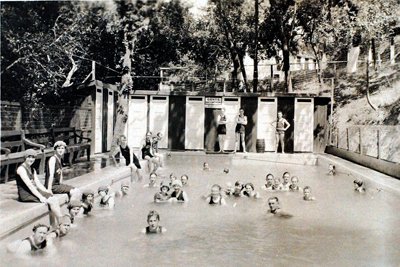On a rainy Friday afternoon in late March, Laura Dominguez-Yon
gave a tour down memory lane of what is now the ghostly shell of
Gilroy Hot Springs tucked away off Roop Road in the mountainous
sanctuary of Henry W. Coe State Park. Full article
Today’s breaking news:
$350K facelift for amphitheater
City honors late employee
So you think you can cook with garlic?
Hunt in full swing for three new GUSD principals
“Where’s Henry?” mused Laura Dominguez-Yon. She turned and peered down a wet dirt road cutting through steep, earthy embankments and emerald hillsides before declaring, “I don’t know. He’s probably off water witching somewhere.”
Sure enough, her 91-year-old bespectacled uncle had splintered from the group and was pensively poking at the ground with a forked stick.
On a rainy Friday afternoon in late March, Dominguez-Yon – who’s family resided at Gilroy Hot Springs from 1945 to 1955 – gave a tour down memory lane of what is now the ghostly shell of an aging 19th century jewel tucked away off Roop Road in the mountainous sanctuary of Henry W. Coe State Park roughly nine miles east of downtown Gilroy.
“I see this great history falling down around my eyes, and it keeps me awake at night,” observed Matt Bischoff, historian of the Monterey District for the Department of Parks and Recreation.
Shaking his head, Bischoff indicated to a mess of graffiti scribbled on the wall of one the original guest cabins.
This pristine oasis on the National Register of Historic Places has experienced a fluctuating relationship with the public, from choice escape for the high-profile and elite, to post World War II hostel for resettling Japanese, to haven of homeopathic healing where relief from ailments was sought, to popular family retreat in the ’50s to decaying landmark nestled in the recesses of isolated overgrowth.
Thanks to old acquaintances however, a new hope is flowing and collecting momentum.
The Friends of Gilroy Hot Springs, an advocacy group formed four years ago by Dominguez-Yon, is making leeway in its encompassing mission of preserving, protecting and restoring public access.
Guided tours are offered and groups can arrange full moon campouts, but Dominguez-Yon’s vision for the facility’s revival is long term and comprehensive.
“Our main focus for activities is to attract a concessionaire to take it over and develop it,” she said. “We want to maintain historic structures, refurbish them and have them habitable.”
In order to open the hot springs for public use and private rentals, she explained, a concessionaire – one who is interested in running a health retreat center utilizing the wellness benefits of the springs – would be necessary since the state parks department doesn’t have resources for insurance and pricey historical renovations.
Dominguez-Yon carefully noted this concessionaire would work in conjunction with the parks department to not only keep public access consistent, but also uphold the natural, historic and architectural integrity of the grounds.
“We need revenues,” she stated, matter-of-factly.
Miniprojects such as laying down new pipes began in November 2010. Eventually Dominguez-Yon wants to see overnight camping, continual day use, regular monthly tours, private rentals and picnicking become mainstays, along with an onsite, live-in camp host who provides security and oversees the picnic area.
“Our goal is to get people to use the park,” she said, standing near the entrance among empty picnic benches.
If anyone was going to spearhead the hot springs’ revival, Dominguez-Yon – her ancestral roots with the grounds run deep – is a perfect fit as the leading proponent for the facility’s rebirth into the 21st century.
She networks diligently with other folks who possess familial ties to the springs such as Bill McDonald, whose grandfather ran the resort from 1901 to 1934, and Russ Mayberry, whose great-grandfather George W. Roop built the resort in 1866.
“Four years ago she called me out of the blue,” said Mayberry, a FOGHS member. “We connected from there and started working.”
In 1938, Roop’s great-grandfather sold the facility to H.K. Sakata, a successful Japanese grower/shipper in Watsonville who owned the springs until 1964.
According to Dominguez-Yon, Sakata’s astuteness allowed him to keep his property through the internment, which provided a means in aiding evacuees who were not able to find homes after the war.
As she led the tour group down a meandering path alongside moss-covered cabins and dilapidated changing rooms, the road came to a bend near the mineral well. It’s still protected by a stately dome covering, the aesthetic structural icon that’s come to symbolize the property.
Dominguez-Yon shuffled downhill to one of the original soaking sights and knelt close to one of the sulfur-scented pools.
“Put your hand in the water,” she instructed.
It was enticingly hot, emerging at temperatures between 95-115 degrees.
“The hot springs was a place of healing,” Dominguez-Yon recalled, standing up against a dense backdrop of ethereal bamboo trees.
If anyone is a living testament to the water’s invigorating powers, it’s got to be Kato, Dominguez-Yon’s chatterbox uncle with a wildly infectious grin. At nine years short of a century old, the resort proprietor of 18 years beginning in 1950 is as sharp as a razor, has a sprightly sense of humor and a healer’s touch – still giving complimentary shiatsu hand massages.
After using a stick to etch out a reproduction of the resort’s old logo in the dirt, he leaned forward and asserted Gilroy Hot Springs is a treasure among natural mineral springs on the global grid.
“No. 3 in the world. I tell you, they don’t know the value.”
He pulled one hand out of his blue down jacket, flashed three fingers and lowered his voice to a whisper.
“No. 3 in the world.”
Toward the end of the tour the suspender-clad Kato busied himself dragging large branches off the walkway, a brief glimmer of his young, professional self who was once in charge of running the resort on a day-to-day basis.
“They destroyed everything after we left,” he said forlornly, referring to vandals and presumably the string of various proprietors who came and vanished over the years.
Looking around at the lonesome but breathtaking acreage, it’s easy to envision socialites from the Marriott, Spreckels and Nestle families lounging by the bathhouses and sipping moonshine iced tea, politician’s wives gossiping over earl gray in the 1939 Japanese garden tea house or lively dance parties lasting into the late hours of steamy summer nights.
“During prohibition, it was the place to be,” said Dominguez-Yon smiling coyly. “You could drink there and gamble there.”
Thanks to the one-way-in, one-way-out road – not to mention the property’s angled position at an incline – lookouts had the advantage, she said.
“Chances are, the sheriff was out there partying with them.”
In addition to its sparkly legacy dotted by patrons of the rich, famous and well-to-do persuasion, the hot springs are a vessel of cultural significance for local Japanese heritage.
Even after being uprooted and relocated to an internment camp during World War II, Sakata returned to the springs and invited 60 displaced families to use the escape as a temporary hostel of solace until they could re-assimilate. He fostered a sense of national pride, purposing himself to share an environmental gift rich in natural beauty and healing capacities.
This sense of pride and ownership is none the weaker in Kato and Dominguez-Yon.
“This is my life’s work here,” said the wiry Kato, looking around and raising his jacketed arms. “This is paradise.”














